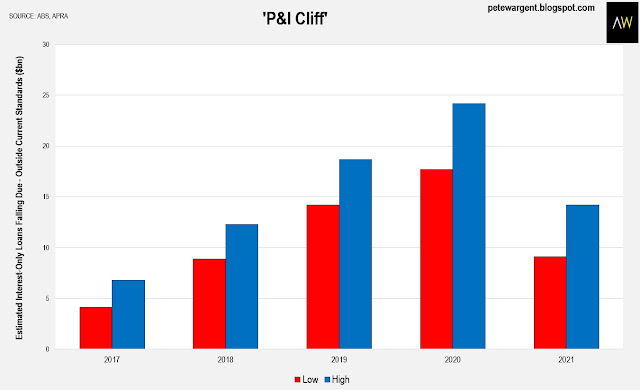Interest-only (IO) loans in Australia typically, though not always, have a term of five years.
At that point, the loan must either be rolled over, or it flips over to become a principal and interest (P&I) loan.
The repayments might be up to ~40 per cent or more higher when the principal payments kick in, so household cashflows need to be carefully managed.
Tighter lending standards have recently been introduced in Australia, leading to speculation that batches of IO loans approved under looser standards will not be rolled over at the end of their IO period.
Australian investors have historically preferred to leave their debt as IO in perpetuity in order to optimise tax deductions, but this privilege may now be taken away for some.
Even some owner-occupiers have been using IO loans, and they too will find it harder to roll over their loans unless they can show an exit strategy (and a future sale of the home won't count).
Impact and timing?
Bank loan books are a movable feast, so it's not possible to say precisely what will happen or how this will all play out.
However, we can look at APRA's implemented restrictions and the value of loans approved outside serviceability.
From there it's possible to make a rough assessment or estimate of the value of IO loans falling due approved under conditions that would likely fail today's underwriting standards.
Today in 2017 there are relatively few such loans falling due, but the value of IO loans falling due will continue to rise sharply over the next three years.
2015 played witness to the peak of the IO loans frenzy, and, being five years later, accordingly 2020 is the year in which the greatest value of 'at risk' IO loans falls due.
Circumstances change over time, of course, but with income growth presently low, these seem to be reasonable estimates of the magnitude of the so-termed "P&I cliff" as things stand today.
By 2016, the share of new IO loans in the market had been pared back, and therefore the P&I cliff will also begin to taper off by 2021.
It remains to be seen to what extent this impacts the housing market.
The wrap: cashflow pain ahead for some
With the flow of new interest-only lending limited to 30 per cent of the total, some existing borrowers will discover that they are unable to roll over their interest-only loans, and they will be forced to start repaying principal.
While some investors refinanced their loans out for half a decade last year, others on skinny yields will be caught short at the end of their interest-only period, and will be forced to begin paying down their loans.
The changes may yet be far from all negative - ultimately banks need to lend to make profits, and some enticing deals may become available on P&I mortgages, and so on.
And, if nothing else, the property markets should in time re-establish a better balance between homebuyers and investors.
Overall, however, this is a change which will suck some of the hot air out of Australia's real estate markets, and will also in turn eventually reduce the stock and flow of available rental properties.
Moreover, there will be plenty of investors that have seen no capital growth and now face the potentially unedifying prospect of a negative cashflow to boot.
In the wash-up, one can't help but feel that investors that opted for quantity over quality of investment properties might be left staring down the barrel of some unenviable decisions.

















